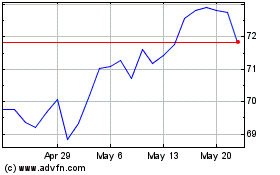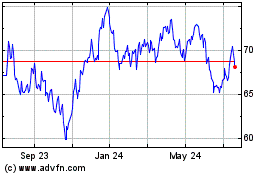Steel ETFs Head-To-Head - Leveraged ETFs
19 January 2012 - 9:45PM
Zacks
While most commodities saw a weak 2011, few were as hard hit as
steel during this tumultuous time frame. After hitting a 52 week
high early in the year of about $900/metric ton, prices of steel
slumped back towards earth by end of year costs coming in below
$800/metric ton. Given that China, which is by far the world’s
biggest consumer of the metal, is apparently slowing down, many are
growing increasingly concerned that prices could continue to slump
here in 2012. If this happens and European demand remains weak, the
highly sensitive steel industry could be in for another rough
year.
Despite these concerns, there are at least a few reasons to be
hopeful about the future of the space in the near term. Many
developed nations are desperate to reinvest in their infrastructure
programs and with the U.S. potentially avoiding a recession, there
could be greater demand on the home front for these new steel-heavy
transit services. Additionally, several other emerging markets
besides China, namely India, are continuing to demand more steel to
support middle class lifestyles. In fact, India was one of the only
countries on the planet that saw growth in steel production in
every year from 2007 to 2010, suggesting that the country’s demand
for the metal is likely to grow even in rough global economic
conditions (see Top Three Emerging Market Consumer ETFs).
Thanks to these realities, it may be worth it to take a closer
look at some of the big players in the beaten down steel industry
for investment. However, it should be noted that the sector
remains fraught with risk and that another recession is certainly
not beyond the realm of possibilities. In light of this, it may be
a good idea to gain exposure to the space in basket form,
specifically with ETFs. Luckily for investors seeking exposure via
this route, there are two ETF options available. While they may
appear similar, there are actually some key differences between the
two that investors should be aware of, which we have highlighted
below:
PowerShares Global Steel Portfolio (PSTL)
This fund tracks the NASDAQ OMX Global Steel Index which is a
benchmark designed to measure the overall performance of globally
traded securities of the largest and most liquid companies involved
in the manufacturing and storage of iron and steel products. The
Index is rebalanced quarterly using a modified, market-cap-weighted
methodology. Currently, the fund holds 70 securities and charges
investors 75 basis points a year in fees for its services (read Top
Three Precious Metal Mining ETFs).
Top individual allocations go to Vale (VALE), ArcelorMittal
(MT), and POSCO (PKX), all of which make up at least 7.6% of the
fund. In terms of country exposure, there is a good deal of variety
with four nations—Japan, Brazil, U.S., and South Korea—all making
up at least 10.5% of total assets. Despite the fund’s solid job of
dividing up assets, PSTL has struggled in recent months, losing
38.5% in the past year. The only saving grace is now the fund has a
P/E ratio below 10 and P/B ratio below 1.0, suggesting that there
could be some long term value that could be unlocked in this fund
if the sector picks up again soon.
Market Vectors Steel Index ETF (SLX)
For another way to play the steel industry, many investors turn
to SLX which tracks the NYSE Arca Steel Index. This benchmark is a
modified market capitalization-weighted index comprised of publicly
traded companies predominantly involved in the production of steel
products or mining and processing of iron ore. The fund charges
investors 55 basis points a year in fees but holds a much smaller
basket of securities than its counterpart at just 27 companies in
total (read Three Low Beta Sector ETFs).
In terms of top holdings, Rio Tinto (RIO) and Vale take the two
top spots, making up 10.9%, and 10.6% of the fund, respectively.
Beyond these two giants, MT and PKX also take up another 6.3% each
as well, while a smattering of firms that make up at least 4.7% of
assets round out the top ten, giving the product a heavier focus on
the top ten securities. For the country breakdown, American
securities dominate the profile of the fund, taking up nearly
two-fifths of total assets. Beyond this, Brazil (22.5%), Luxembourg
(12.3%), and the UK (12.2%) all receive double digit allocations as
well (see ETFs vs. Mutual Funds).
While SLX hasn’t beaten PSTL by much on the performance front
(roughly 300 basis points over the course of the year), the fund
does have a much lower expense ratio and better volume. This could
mean that the fund may be a better choice for investors looking for
tight bid ask spreads and lower overall costs. These cheaper costs
also come in addition to comparable figures on both the P/E and P/B
fronts, suggesting similar value in the underlying holdings.
However, it is important to remember that the fund is far more
concentrated in its top holdings and that it has less depth across
the broad steel producing industry.
|
Category
|
PSTL
|
SLX
|
|
Total Holdings
|
70
|
27
|
|
% in Top Ten
|
50.2%
|
68.6%
|
|
2011 Performance
|
-38.5%
|
-35.6%
|
|
Expense Ratio
|
0.75%
|
0.55%
|
|
Volume (Daily Average)
|
4,100
|
119,547
|
Want the latest recommendations from Zacks Investment Research?
Today, you can download 7 Best Stocks for the Next 30
Days. Click to get this free report >>
ARCELOR MITTAL (MT): Free Stock Analysis Report
POSCO-ADR (PKX): Free Stock Analysis Report
RIO TINTO-ADR (RIO): Free Stock Analysis Report
VALE RIO DO-ADR (VALE): Free Stock Analysis Report
To read this article on Zacks.com click here.
Zacks Investment Research
Want the latest recommendations from Zacks Investment Research?
Today, you can download 7 Best Stocks for the Next 30 Days. Click
to get this free report
VanEck Steel ETF (AMEX:SLX)
Historical Stock Chart
From Dec 2024 to Jan 2025

VanEck Steel ETF (AMEX:SLX)
Historical Stock Chart
From Jan 2024 to Jan 2025
